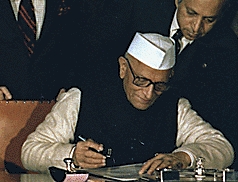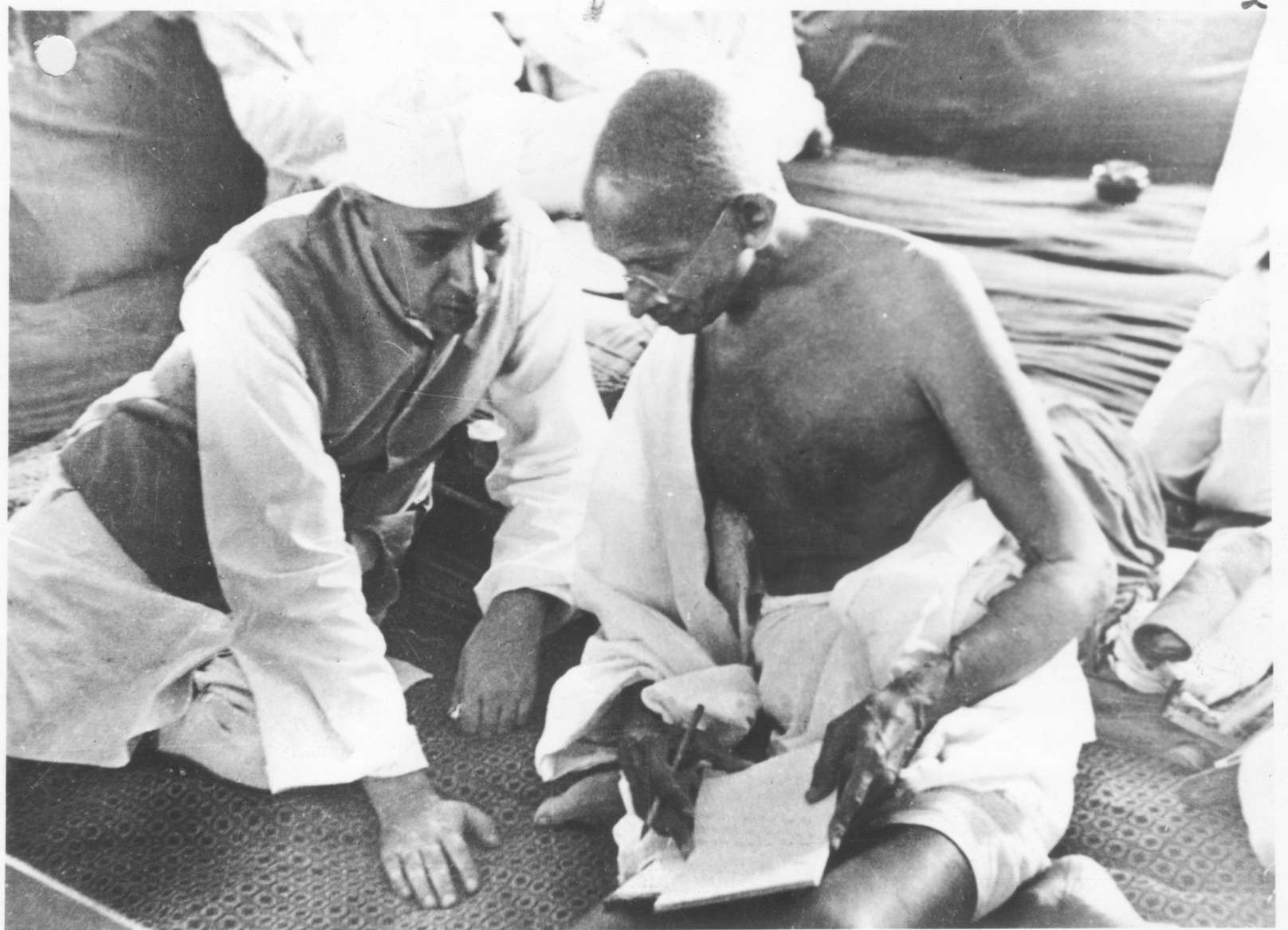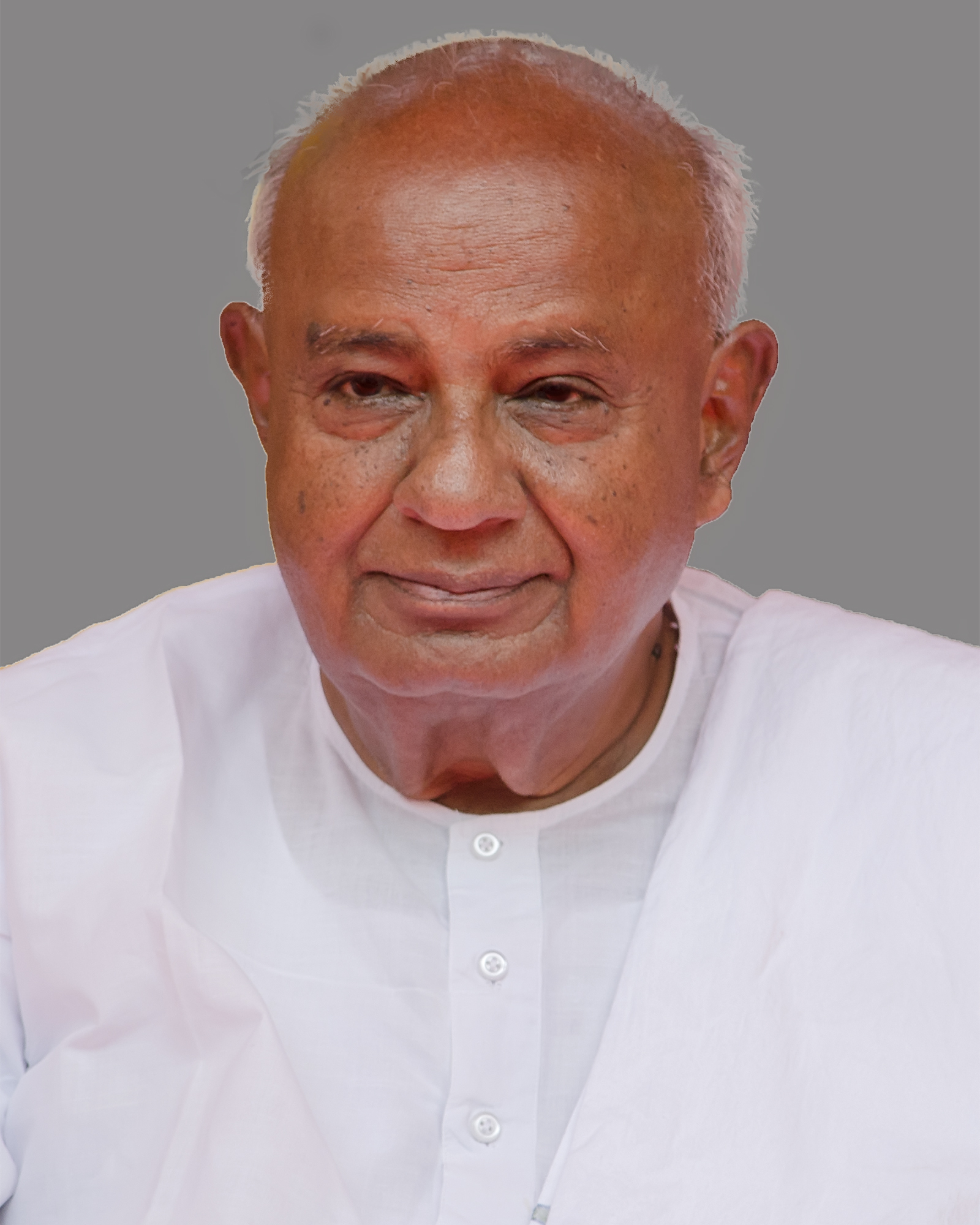|
S R Bommai
Somappa Rayappa Bommai (6 June 1924 – 10 October 2007) was an Indian Politician who was the 11th Chief Minister of Karnataka. He was also the Human Resource Development Minister in the United Front government from 1996 to 1998. He is widely remembered as the champion for the landmark judgment of the Supreme Court of India, S. R. Bommai v. Union of India. His son Basavaraj Bommai became the Chief Minister of Karnataka in 2021 making them only the second father and son duo after H. D. Devegowda and H. D. Kumaraswamy to become the Chief Ministers of Karnataka. __TOC__ Early life and political career S. R. Bommai was born on 6 June 1924 in a Sadar Lingayat family at Karadagi village of Shiggaon taluk of the then undivided Dharwad District. He took part in the Quit India movement of 1942. He also played an active role in the unification (''Ekikarana'' in Kannada) of Karnataka which had been spread among Mysore kingdom, Bombay Presidency, Hyderabad, and Madras Presidency, duri ... [...More Info...] [...Related Items...] OR: [Wikipedia] [Google] [Baidu] |
Karadagi
Karadagi is a village in the southern state of Karnataka, India.Village code= 824600 Karadagi, Haveri, Karnataka It is located in the Savanur taluk of Haveri district in Karnataka. Demographics India census, Karadagi had a population of 5451 with 2822 males and 2629 females. See also * Haveri * Districts of Karnataka The Indian State of Karnataka consists of 31 districts grouped into 4 administrative divisions. The state geographically has 3 principal regions: the coastal region of Karavali, the hilly Malenadu region comprising the Western Ghats, and the ... References External links * http://Haveri.nic.in/ Villages in Haveri district {{Haveri-geo-stub ... [...More Info...] [...Related Items...] OR: [Wikipedia] [Google] [Baidu] |
Janata Party
The Janata Party ( JP, lit. ''People's Party'') was a political party that was founded as an amalgam of Indian political parties opposed to the Emergency that was imposed between 1975 and 1977 by Prime Minister Indira Gandhi of the Indian National Congress. In the 1977 general election, the party defeated the Congress and Janata leader Morarji Desai became the first non-Congress prime minister in independent modern India's history. Raj Narain, a socialist leader, had filed a legal writ alleging electoral malpractice against Indira Gandhi in 1971. On 12 June 1975, Allahabad High Court found her guilty of using corrupt electoral practices in her 1971 election victory over Narain in the Rae Bareli constituency. She was barred from contesting any election for the next six years. Economic problems, corruption and the conviction of Gandhi led to widespread protests against the Congress (R) government, which responded by imposing a State of Emergency. The rationale was that of pr ... [...More Info...] [...Related Items...] OR: [Wikipedia] [Google] [Baidu] |
The Hindu
''The Hindu'' is an Indian English-language daily newspaper owned by The Hindu Group, headquartered in Chennai, Tamil Nadu. It began as a weekly in 1878 and became a daily in 1889. It is one of the Indian newspapers of record and the second most circulated English-language newspaper in India, after '' The Times of India''. , ''The Hindu'' is published from 21 locations across 11 states of India. ''The Hindu'' has been a family-owned newspaper since 1905, when it was purchased by S. Kasturi Ranga Iyengar from the original founders. It is now jointly owned by Iyengar's descendants, referred to as the "Kasturi family", who serve as the directors of the holding company. The current chairperson of the group is Malini Parthasarathy, a great-granddaughter of Iyengar. Except for a period of about two years, when S. Varadarajan held the editorship of the newspaper, the editorial positions of the paper were always held by members of the family or held under their direction. Histo ... [...More Info...] [...Related Items...] OR: [Wikipedia] [Google] [Baidu] |
Kannada
Kannada (; ಕನ್ನಡ, ), originally romanised Canarese, is a Dravidian language spoken predominantly by the people of Karnataka in southwestern India, with minorities in all neighbouring states. It has around 47 million native speakers, and was additionally a second or third language for around 13 million non-native speakers in Karnataka. Kannada was the court language of some of the most powerful dynasties of south and central India, namely the Kadambas, Chalukyas, Rashtrakutas, Yadava Dynasty or Seunas, Western Ganga dynasty, Wodeyars of Mysore, Nayakas of Keladi Hoysalas and the Vijayanagara empire. The official and administrative language of the state of Karnataka, it also has scheduled status in India and has been included among the country's designated classical languages.Kuiper (2011), p. 74R Zydenbos in Cushman S, Cavanagh C, Ramazani J, Rouzer P, ''The Princeton Encyclopedia of Poetry and Poetics: Fourth Edition'', p. 767, Princeton Unive ... [...More Info...] [...Related Items...] OR: [Wikipedia] [Google] [Baidu] |
Quit India Movement
The Quit India Movement, also known as the August Kranti Movement, was a movement launched at the Bombay session of the All India Congress Committee by Mahatma Gandhi on 8th August 1942, during World War II, demanding an end to British rule in India. After the failure of the Cripps Mission to secure Indian support for the British war effort, Gandhi made a call to ''Do or Die'' in his Quit India movement delivered in Bombay on 8 August 1942 at the Gowalia Tank Maidan. The All India Congress Committee launched a mass protest demanding what Gandhi called "An Orderly British Withdrawal" from India. Even though it was at war, the British were prepared to act. Almost the entire leadership of the Indian National Congress was imprisoned without trial within hours of Gandhi's speech. Most spent the rest of the war in prison and out of contact with the masses. The British had the support of the Viceroy's Council, of the All India Muslim League, the Hindu Mahasabha, the princely state ... [...More Info...] [...Related Items...] OR: [Wikipedia] [Google] [Baidu] |
Dharwad
Dharwad (), also known as Dharwar, is a city located in the north western part of the Indian state of Karnataka. It is the headquarters of the Dharwad district of Karnataka and forms a contiguous urban area with the city of Hubballi. It was merged with Hubballi in 1962 to form the twin cities of Hubballi–Dharwad, Hubballi-Dharwad. It covers an area of and is located northwest of Bangalore, on National Highway 48 (India), NH-48, between Bangalore and Pune. Etymology The word "Dharwad" is derived from the Sanskrit word 'dwarawata', 'dwara' meaning "door" and 'wata' or 'wada' meaning "town". It means a place of rest in a long travel or a small habitation. For centuries, Dharwad acted as a resting place for travellers and a gateway between the ''Malenadu'' (western mountains) and the ''Bayalu Seeme'' (plains). History The Chalukyas ruled Dharwad during the 12th century. A stone inscription indicates that there was a ruler by the name of BhaskaraDeva in 1117. In the 14th century ... [...More Info...] [...Related Items...] OR: [Wikipedia] [Google] [Baidu] |
Shiggaon
Shiggaavi is a municipal town in Haveri district in the Indian state of Karnataka. Geography Shiggaon is about 365 km from Bengaluru and 465 km from Pune on the NH-48 (National Highway 4). Shiggaon taluk was earlier in Dharwad district. In the year 1997–98, Dharwad district was divided into three districts: Dharwad with five taluks (Dharwad, Hubli, Kalghatgi, Kundgol and Navalgund), Gadag district with five taluks (Gadag, Ron, Nargund, Mundargi and Shirahatti) and Haveri district with seven taluks (Haveri, Byadgi, Ranebennur, Hirekerur, Hangal, Shiggaon and Savanur). Shiggaon taluk is bounded by Dharwad district in the North, Savanur taluk in the East, Hangal taluk in the South and Mundagod Taluk of Uttara Kannada district in the West. Shiggaon taluk has 91 villages, 25 Gram Panchayats and 2 City Municipal Councils (Shiggaon and Bankapur). The taluk lies between North latitude 14’.28o to 14’.59o and East longitude 75’.07o to 75’.38o. The area of the taluk is ... [...More Info...] [...Related Items...] OR: [Wikipedia] [Google] [Baidu] |
Sadar Lingayats
Sadar Lingayats (Kannada:ಸಾದರ ಲಿಂಗಾಯತ), sometimes also spelled as ''Sadhu Lingayats'', are a Lingayat community that inhabit Central Karnataka region of the Karnataka state in India. The land-owning feudal community vows its allegiance to Taralabalu Jagadguru Brihanmath, Sirigere. It is one of the dominant sub-castes of the Lingayat community. Gowda, Patel, Patil, Gowdagere and Banakar are some of the prominent surnames used by the community. History The Sadhu Lingayats initially lived in the northern part of modern day Karnataka, where agriculture was their primary livelihood. When a local king attacked the region, which was ruled by his father-in-law, some of these people moved south. Later, others following them south converted to Lingayathism. Haalu Rameshwara, Viswabandhu Marulasiddha, Narappa, Mahdeswara, Karibasajja and Dyamalamba are noted saints of the community, and Harihara and Raghavanka are some noted poets. The non-Lingayats are divided ... [...More Info...] [...Related Items...] OR: [Wikipedia] [Google] [Baidu] |
Supreme Court Of India
The Supreme Court of India ( IAST: ) is the supreme judicial authority of India and is the highest court of the Republic of India under the constitution. It is the most senior constitutional court, has the final decision in all legal matters except for personal laws and interstate river disputes, and also has the power of judicial review. The Chief Justice of India is the Head and Chief Judge of the Supreme Court, which consists of a maximum of 34 judges, and has extensive powers in the form of original, appellate and advisory jurisdictions. New judges here are uniquely nominated by existing judges and other branches of government have neglible say as the court follows collegium system for appointments. As the apex and most powerful constitutional court in India, it takes up appeals primarily against verdicts of the High Courts of various states of the Union and other courts and tribunals. It is required to safeguard the fundamental rights of citizens and settles dispute ... [...More Info...] [...Related Items...] OR: [Wikipedia] [Google] [Baidu] |
United Front (India)
The United Front was a coalition government of 13 political parties formed in India after the 1996 general elections. The coalition formed two governments in India between 1996 and 1998. The government was headed by two Prime Ministers from Janata Dal – H. D. Deve Gowda, and I. K. Gujral. N. Chandrababu Naidu of the Telugu Desam Party served as the convener of United Front. Headquartered at the Andhra Pradesh Bhavan at New Delhi. Background The Indian general election in 1996 returned a fractured verdict. With the Bharatiya Janata Party (BJP) emerging as the largest party, with 161 of 543 seats, it was invited first to form a government. It accepted the offer, and Atal Bihari Vajpayee was sworn in as prime minister. However, he was unable to muster a majority on the floor of the house, and the government fell 13 days later.At a meeting of all the other parties, the Indian National Congress, with a substantial 140 seats, declined to head the government and agreed to exten ... [...More Info...] [...Related Items...] OR: [Wikipedia] [Google] [Baidu] |
Ministry Of Human Resource Development (India)
The Ministry of Education ( MoE; formerly the Ministry of Human Resource Development from 1985 to 2020) is a ministry of the Government of India, responsible for the implementation of the National Policy on Education. The Ministry is further divided into two departments: the Department of School Education and Literacy, which deals with primary, secondary and higher secondary education, adult education and literacy, and the Department of Higher Education, which deals with university level education, technical education, scholarships, etc. The current education minister is Dharmendra Pradhan, a member of the Council of Ministers. India had the Ministry of Education since 1947. In 1985, Rajiv Gandhi government changed its name to Ministry of Human Resource Development (MHRD) and with the public announcement of newly drafted "National Education Policy 2020" by the Narendra Modi government, Ministry of Human Resource Development was renamed back to Ministry of Education. Policy ... [...More Info...] [...Related Items...] OR: [Wikipedia] [Google] [Baidu] |
Chief Minister
A chief minister is an elected or appointed head of government of – in most instances – a sub-national entity, for instance an administrative subdivision or federal constituent entity. Examples include a state (and sometimes a union territory) in India; a territory of Australia; a province of Sri Lanka or Pakistan; a federal province in Nepal; an autonomous region of Philippines; or a British Overseas Territory that has attained self-governance. It is also used as the English version of the title given to the heads of governments of the Malay states without a monarchy. The title is also used in the Crown Dependencies of the Isle of Man (since 1986), in Guernsey (since 2004), and in Jersey (since 2005). In 2018 Sierra Leone, a presidential republic, created the role of an appointed chief minister, which is similar to a prime minister in a semi-presidential system. Before that, only Milton Margai had the same position between 1954 and 1958. [...More Info...] [...Related Items...] OR: [Wikipedia] [Google] [Baidu] |






